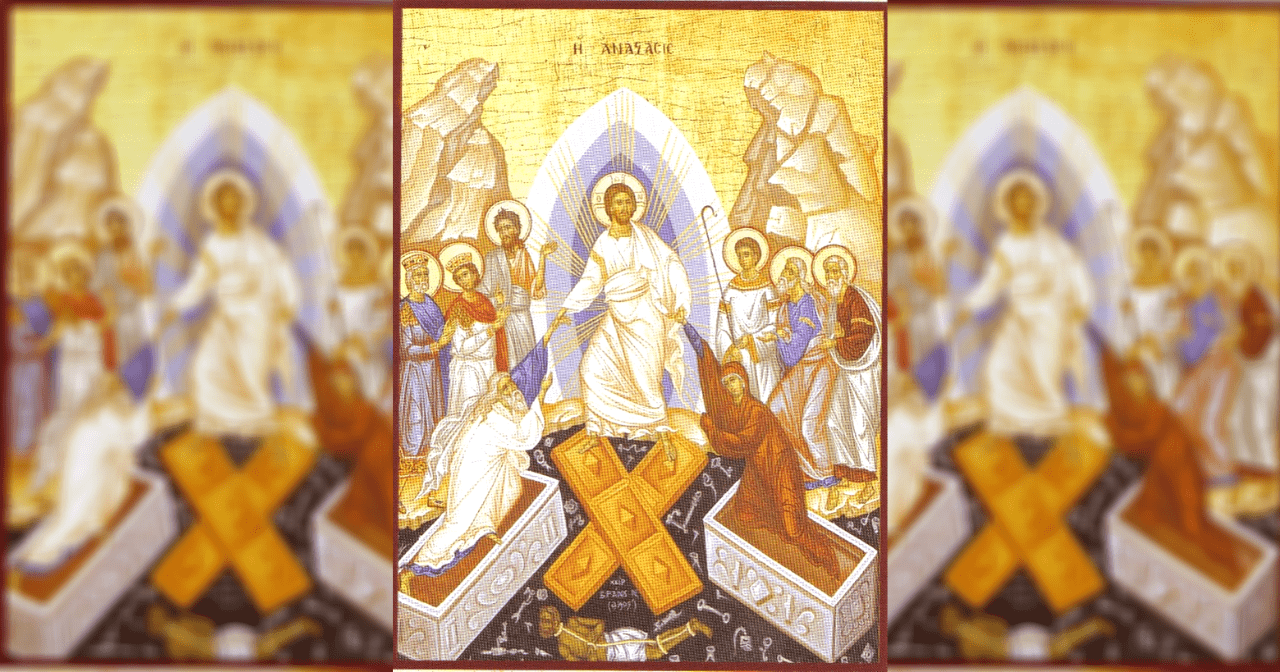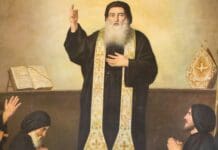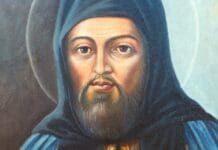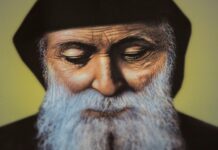By Phillip Rolfes
We’ve finally come to the good stuff—actually interpreting and icon!
But first, let’s recap a couple of things…
As we discovered in the first article, icons are not “religious art,” but are more properly liturgical art. In order to accurately interpret an icon, you have to turn to the liturgical texts of the feast being celebrated, as well as the relevant biblical texts. This requires your active participation in the mystery being depicted, and not just a passive gaze. Icons, therefore, are not “windows into Heaven,” but more accurately liturgical doorways through which we enter into the mysteries.
Secondly, icons have their own system of signs and symbols. Colors, gestures, inscriptions, postures, and persons each have meaning that must be factored into the interpretation of an icon.
Finally, icons are arranged along a vertical and a horizontal axis, with the central figure(s) and action situated at the intersection of those axes. The figures and actions to the right and the left of the central theme are all oriented toward that theme. When it comes to the Great Feasts of the Church, this arrangement shows that the mysteries of Christ’s life (and of the Christian life in general) must be understood through the lens of the Cross.
How It Works
Let’s return to the icon of the “Harrowing of Hades” and put some of this theory into practice.
- The Vertical Axis
At the point where the vertical and the horizontal axes meet stands the figure of the risen Christ. Shining out behind Him is the mandorla, indicating that He is manifesting His divine power and glory. He’s also clothed in pure white, showing forth the light of His glory. Ode 1 of Matins proclaims, “Let us purify our senses, and we shall behold Christ radiant with the unapproachable light of the Resurrection.”
Looking at His posture we see that Christ isn’t a static figure, but is very dynamic—he’s alive and active. He stands—or rather tramples—on the broken gates of Hades as the One Who has shattered the power of death itself. As is sung over and over throughout the Easter liturgical celebrations: “Christ is risen from the dead, trampling down death by death, and upon those in the tombs bestowing life.”Did you catch that? Christ has trampled death by death. It’s through His Cross that He descended into the realm of the dead; the broken gates of Hades are themselves in the form of a cross. The Hymn of the Resurrection sung during Matins makes this explicit: “[F]or, having endured crucifixion, He hath destroyed death by death.”Beneath the broken gates is the black realm of Hades. Scattered throughout the realm are bits of broken bonds, keys, and bars. These are the bonds that once held mankind captive, but that Christ has broken in order to set man free from the power of sin and death. Ode 6 from of Matins declares, “Thou [Christ] didst descend into the nethermost parts of the earth, and didst shatter the eternal bars that held the fettered [mankind]…”Finally, below the shattered gates of Hades there’s an odd figure who’s bound from his neck to his ankles. This calls to mind the passage from the Gospel of Mark where Christ says: “No one can enter a strong man’s house to plunder his property unless he first ties up the strong man. Then he can plunder his house” (Mark 3:27).Through sin, you and I were made (or, more properly, made ourselves) the “propert”” of Satan—we became his slaves. But Christ came to reverse the effects of sin, to bind up the “strong man,” and plunder his house, setting us captives free.We could go on and on, but let’s turn to the horizontal axis.
- The Horizontal Axis
Again, Christ is the central figure. But what’s the central action here? To the right and left of Christ are Adam and Eve, who symbolize the entire human race. Christ, holding each one by the wrist, is pulling them out of their tombs. He holds their wrists to show us that you and I have no power to free ourselves from the bonds of sin and death. We are set free by His action alone.In Ode 6 of Matins we sing, “Thou didst raise up with Thyself the whole race of Adam, when Thou didst rise from the tomb.”But even though we are powerless to free ourselves from the bonds of sin and death, we must still cooperate with Christ’s saving action. Adam and Eve themselves appear to be trying to stand up out of their tombs to meet the risen Christ. “Seeing Your boundless compassion, they who were held in the bonds of Hades hastened to the light, O Christ, with gladsome feet, praising the eternal Pascha” (Ode 5). It’s almost as if Adam and Eve are attempting to dance with joy as they are set free from sin and death.When you look at Adam and Eve’s clothing, you’ll see that they are clothed in blue, thus indicating their humanity. But over their blue clothing is another garment. The figure of Adam is clothed in the white glory of Christ’s Resurrection. And Eve is clothed in the red of Christ’s divinity. “He… became man, suffered as a mortal, and through His Passion doth clothe mortality with the beauty of incorruption” (Ode 7).This truth is drawn out in a particularly powerful way every Sunday in the Maronite Qurbono (Mass) when we pray:
You have united, O Lord,
Your divinity with our humanity,
and our humanity with your divinity,
Your life with our mortality,
and our mortality with your life.
You have assumed what is ours,
and you have given us what is yours,
for the life and salvation of our souls.You and I have a great dignity indeed! We are called to be sharers in Christ’s own glory, and to be partakers of His divine nature. In the West this is called “deification.” In the East we call it theosis. As St. Paul says, “I… urge you to live in a manner worthy of the call you have received” (Eph. 4:1). Here before your eyes, in lines and color, is the great dignity of the “call which you have received.” This icon challenges you and I to examine ourselves to see if we are conforming our lives to this great dignity.
There is more that can be said about this icon, but I hope this little series has whet your appetite and left you wanting to learn more.
If you’ve enjoyed this series, then I encourage you to pick up of a copy of Professor Schneider’s video series The Great Feasts: An Iconological Journey. It’s absolutely phenomenal, and will guide you through the riches of iconography in ways that an article never could.
 Phillip Rolfes is That Eastern Catholic Guy. A “canonical convert” from Roman Catholicism to Maronite Catholicism, Phillip loves researching and sharing the rich traditions of the Christian East. He lives in Cincinnati, OH. with his wife and four children, and is parishioner at St. Anthony of Padua Maronite Catholic Church.
Phillip Rolfes is That Eastern Catholic Guy. A “canonical convert” from Roman Catholicism to Maronite Catholicism, Phillip loves researching and sharing the rich traditions of the Christian East. He lives in Cincinnati, OH. with his wife and four children, and is parishioner at St. Anthony of Padua Maronite Catholic Church.


















Lily, Make 6150 bucks every month… Start doing online computer-based work through our website. I have been working from home for 4 years now and I love it. I don’t have a boss standing over my shoulder and I make my own hours. The tips below are very informative and anyone currently working from home or planning to in the future could use this website……… Details Here